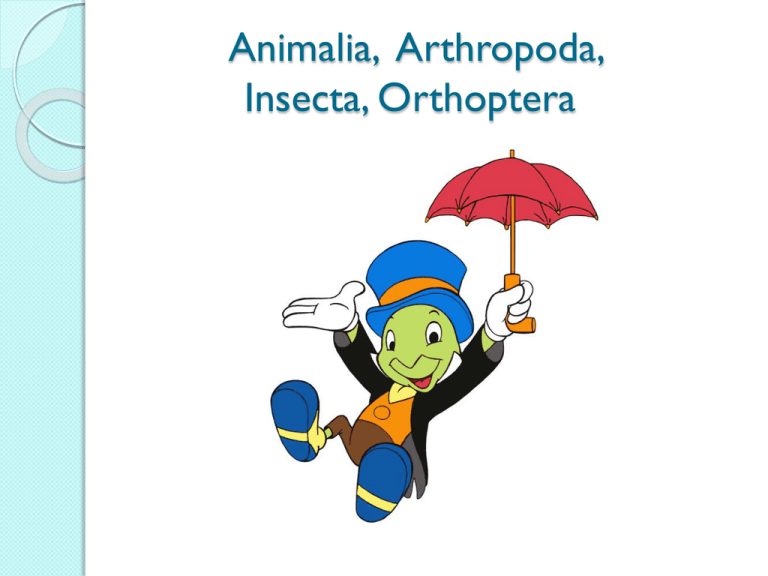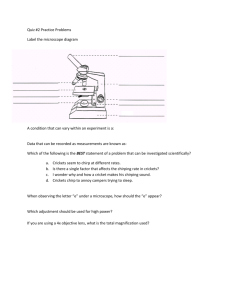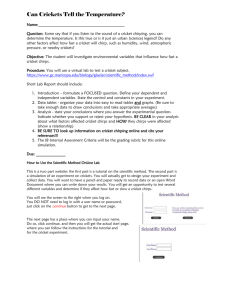Animalia, Insecta, Orthoptera
advertisement

Animalia, Arthropoda, Insecta, Orthoptera Anatomy of a Cricket Cricket Navigation - finding their way around - is a challenging problem for robots but crickets have inspired computer scientists at the University of Stirling to come up with a new way for robots to do it. Female crickets can find male crickets by homing in on the song they sing. A cricket's ears are actually in their front legs. Sounds arrive at the ears, which being on the legs are as far a part as is possible in a cricket. The legs act as long tubes down which waves of pressure pass as a result of the sound waves hitting them. A sound on one side of the cricket arrives at the ear on that side sooner than the other ear. This turns into a different amount of pressure in the tubes on either side of the crickets head. The cricket's brain can work out locations from the pressure differences, telling the cricket where the sound is coming from. The Stirling researchers have created a similar mechanism to work in robots allowing them to navigate towards sounds. It uses an artificial brain that works in a similar way to a cricket's to turn the pressure signals from the sound into the knowledge of where to go. It uses what is known as a neural network - a computer version of the neurons in biological brains. Cricket Small, nocturnal animal Long back legs & long feelers Similar to grasshoppers, but they have short feelers Male crickets chirp to attract mates Omnivores Cold-blooded Ears(tympanic membranes)on their legs Insect Eating/Entomophagy Crickets are considered a delicacy in Asia & Africa Cricket Pad Thai INGREDIENTS • 8 to 10 ounces dried rice stick noodles • 6 tablespoon fish sauce • 2 tablespoon soy sauce • 6 tablespoon lime juice • 4 teaspoons organic sugar) • 4 tablespoon peanut oil • 1 cup crickets (prepared properly) • 3 to 4 cloves garlic • 3 eggs lightly beaten • 0.5 cup finely chopped scallions • 2 cup bean sprouts • 0.25 cup crushed peanuts • 0.5 cup fresh cilantro • 1 lime cut into wedges to serve to each person Food Value of Crickets 100 grams of cricket 121 calories 12.9 grams of protein5.5g of fat 5.1g of carbohydrates 75.8 mg calcium 185.3 mg of phosphorous 9.5 g of iron O.36 mg of thiamin 1.09mg riboflavin 3.10mg of niacin (Crickets have a better feed to meat ratio than any other animal) Did you know? Crickets are popular pets. Crickets are used for fighting as a gambling pastime. Crickets are considered good luck in Asia & if you are Pinocchio Crickets in folklore are a sign of impeding rain or of a financial windfall. Cricket is a game. Cricket is the name for a harmonica. Cricket chirping Male wings have a rough surface (file) on under side and the top of the wing has a scrapper. Males rub their wings together (stridulation). Stridulation is species-specific. There are 4 types of song- calling, aggressive, courting & copulating. Link to U tube chirping Now let’s do some cricket math If the crickets aren't chirping inside your house, maybe you should turn up the heat. Crickets usually don't chirp when the temperature's below 55 degrees (F). Above 55, you can count the number of chirps made in a 15 second period and add 40 to find the temperature inside your house*. Considering the price of fuel this coming winter, reducing the number of cricket chirps will provide extra motivation to conserve and will save you money. *This is A.E.Dolbear's formula - he was a Physics professor at Tuft's College in 1897.You really need to find out what kind of crickets you have if you want the precise temperature: Field Cricket: T = 50 + (N – 40) / 4 Snowy Tree Cricket: T = 50 + (N – 92) / 4.7 Katydid: T = 60 + (N – 19) / 3 For all three, T is the temperature and N is the number of chirps per minute. Handouts Cricket math Functional response of the Venus flytrap http://wwwrohan.sdsu.edu/~jmahaffy/courses/s00a/math12 1/labs/laba/q3v1.htm




